Coronitic Associations at Gabrish in the Kovdozero Layered Complex in the Southern Part of the Lapland—Belomorian Belt, Kola Peninsula, Russia
Abstract
1. Introduction
2. Regional Geology and Sampling
3. Materials and Methods
4. Results and Observations
4.1. Overall Variations and Cryptic Layering
4.2. Geochemical Trends
5. Discussion
5.1. Crystallization of the Kovdozero Complex Based on Evidence at Gabrish
5.2. Origin of the Coronas
6. Concluding Statements
Supplementary Materials
Author Contributions
Funding
Data Availability Statement
Acknowledgments
Conflicts of Interest
References
- Nikolaeva, K.A.; Smirnova, V.S.; Shurkin, K.A. The Geological Map of the USSR on the Scale of 1:200,000; Kola Series (Q-36-VIII); Northwestern Geological Department, Ministry of Geology and Subsoil Protection of the USSR, Gosgeoltekhizdat Publisher: Moscow, Russia, 1960. [Google Scholar]
- Efimov, A.A. Geological Structure, Conditions of Formation and Platinum Potential of the Kovdozero Basic-Hyperbasic Massif, Northwestern Belomor’ye. Ph.D. Thesis, Geological Institute, Kola Science Centre, Apatity, Russia, 1999; 124p. (In Russian). [Google Scholar]
- Barkov, A.Y.; Laajoki, K.V.O.; Karavaev, S.S. First occurrences of Pd−Pt minerals in the Kovdozero mafic−ultramafic complex, NE Fennoscandian Shield. In Mineral Deposits; Papunen, H., Ed.; Balkema: Rotterdam, The Netherlands, 1997; pp. 393–394. [Google Scholar]
- Efimov, A.A.; Kaulina, T.V. Geological features and U−Pb dating (first data) in the southeastern part of the Kovdozero basic—Hyperbasic massif (the Puakhta block). In The Belomorian Mobile Belt (Geology, Geodynamics, Geochronology), Proceedings of the Abstracts International Conference Institute of Geology, Karelian Science Centre, Petrozavodsk, Russia, 1–4 September 1997; Institute of Geology, Karelian Science Centre: Petrozavodsk, Russia, 1997; p. 31. (In Russian) [Google Scholar]
- Fedorov, E.S. On a new group of igneous rocks. Proc. Moscow Agricult. Inst. 1896, 1, 12–29. (In Russian) [Google Scholar]
- Sharkov, E.V.; Snyder, G.A.; Taylor, L.A.; Zinger, T.F. An Early Proterozoic large igneous province in the Eastern Baltic Shield: Evidence from the mafic Drusite Complex, Belomorian Mobile Belt, Russia. Int. Geol. Rev. 1999, 41, 73–93. [Google Scholar] [CrossRef]
- Sharkov, E.V.; Krassivskaya, I.S.; Chistyakov, A.V. Belomorian drusite (coronite) complex, Baltic Shield, Russia: An example of dispersed intrusive magmatism in early Paleoproterozoic mobile zones. Russ. J. Earth Sci. 2004, 6, 185–215. [Google Scholar] [CrossRef]
- Malov, N.D. Structural-petrological and specific metallogenic features of drusites in the north-western Belomorye. Vestn. St. Petersbg Univ. Earth Sci. 2015, 7, 73–84. (In Russian) [Google Scholar]
- Terekhov, E.N. Lapland–Belomorian mobile belt as an example of the root zone of the Paleoproterozoic rift system of the Baltic Shield. Litosfera 2007, 6, 15–39. (In Russian) [Google Scholar]
- Barkov, A.Y.; Martin, R.F.; Korolyuk, V.N.; Lobastov, B.M. The coronitic Perchatka layered intrusion, central Lapland—Belomorian Belt, Kola Peninsula, Russia. Can. J. Mineral. Petrol. 2025, 63. accepted. [Google Scholar]
- Krivolutskaya, N.A.; Svirskaya, N.M.; Belyatsky, B.V.; Smolkin, V.F.; Mamontov, V.P.; Fanygin, A.S. Geochemical specifics of massifs of the drusite complex in the central Belomorian mobile belt. II. Sm−Nd isotopic system of the rocks and the U−Pb isotopic system of zircons. Geochem. Int. 2010, 48, 1064–1083. [Google Scholar] [CrossRef]
- Serov, P.A.; Bayanova, T.B.; Steshenko, E.N.; Kunakkuzin, E.L.; Borisenko, E.S. Metallogenic setting and evolution of the Pados-Tundra Cr-bearing ultramafic complex, Kola Peninsula: Evidence from Sm–Nd and U–Pb isotopes. Minerals 2020, 10, 186. [Google Scholar] [CrossRef]
- Barkov, A.Y.; Korolyuk, V.N.; Barkova, L.P.; Martin, R.F. Double-front crystallization in the Chapesvara ultramafic subvolcanic complex, Serpentinite Belt, Kola Peninsula, Russia. Minerals 2019, 10, 14. [Google Scholar] [CrossRef]
- Barkov, A.Y.; Nikiforov, A.A.; Barkova, L.P.; Korolyuk, V.N.; Martin, R.F. Zones of PGE–chromite mineralization in relation to crystallization of the Pados-Tundra ultramafic complex, Serpentinite Belt, Kola Peninsula, Russia. Minerals 2021, 11, 68. [Google Scholar] [CrossRef]
- Barkov, A.Y.; Nikiforov, A.A.; Barkova, L.P.; Izokh, A.E.; Korolyuk, V.N. Komatiitic subvolcanic rocks in the Mount Khanlauta massif, Serpentinite Belt (Kola Peninsula). Russ. Geol. Geophys. 2022, 63, 981–1000. [Google Scholar] [CrossRef]
- Barkov, A.Y.; Nikiforov, A.A.; Korolyuk, V.N.; Martin, R.F. The Lyavaraka ultrabasic complex, Serpentinite Belt, Kola Peninsula, Russia. Geosciences 2022, 12, 323. [Google Scholar] [CrossRef]
- Barkov, A.Y.; Nikiforov, A.A.; Korolyuk, V.N.; Martin, R.F. Mineral–geochemical and geotectonic features of the Lotmvara-II ultrabasic sill, Serpentinite Belt (Kola Peninsula). Russ. Geol. Geophys. 2023, 64, 1161–1178. [Google Scholar] [CrossRef]
- Barkov, A.Y.; Nikiforov, A.A.; Martin, R.F.; Silyanov, S.A.; Lobastov, B.M. The Tepsi ultrabasic intrusion, northern part of the Lapland−Belomorian Belt, Kola Peninsula, Russia. Minerals 2024, 14, 685. [Google Scholar] [CrossRef]
- Barkov, A.Y.; Nikiforov, A.A.; Martin, R.F.; Korolyuk, V.N. Corona-type textures in ultrabasic complexes of the Serpentinite Belt, Kola Peninsula, Russia. Minerals 2023, 13, 115. [Google Scholar] [CrossRef]
- Mindlina, A.A.; Shukevich, A.M. The Geological Map of the USSR on the Scale of 1:200,000; Kola Series (R-35-XXXV, XXXVI); Northwestern Geological Department, Ministry of Geology and Subsoil Protection of the USSR, Gosgeoltekhizdat Publisher: Moscow, Russia, 1959. [Google Scholar]
- Vrachinskaya, M.M.; Karpinskaya, N.V.; Shurkin, K.A. The Geological Map of the USSR on the Scale of 1:200,000; Kola Series (Q-36-IX); North-western Geological Department, Ministry of Geology and Subsoil Protection of the USSR, Gosgeoltekhizdat Publisher: Moscow, Russia, 1959. [Google Scholar]
- Belyaev, K.D.; Polferov, D.V. The Geological Map of the USSR on the Scale of 1:200,000; Kola Series (R-36 XXXI, XXXII); North-western Geological Department, Ministry of Geology and Subsoil Protection of the USSR, Gosgeoltekhizdat Publisher: Moscow, Russia, 1962. [Google Scholar]
- Lunina, O.P.; Roginskaya, B.I.; Shurkin, K.A. The Geological Map of the USSR on the Scale of 1:200,000; Kola Series (Q-36-I); North-western Geological Department, Ministry of Geology and Subsoil Protection of the USSR, Gosgeoltekhizdat Publisher: Moscow, Russia, 1962. [Google Scholar]
- Solodkaya, R.I.; Perevozchikova, V.A. The Geological Map of the USSR on the Scale of 1:200,000; Kola Series (Q-36-II); North-western Geological Department, Ministry of Geology and Subsoil Protection of the USSR, Gosgeoltekhizdat Publisher: Moscow, Russia, 1963. [Google Scholar]
- Leontyeva, O.P.; Belonin, M.D.; Shurkin, K.A. The Geological Map of the USSR on the Scale of 1:200,000; Kola Series (Q-35-VI); North-western Geological Department, Ministry of Geology and Subsoil Protection of the USSR, Gosgeoltekhizdat Publisher: Moscow, Russia, 1964. [Google Scholar]
- Popova, V.A.; Robonen, V.I. The Geological Map of the USSR on the Scale of 1:200,000; Kola Series (Q-36-VII); North-western Geological Department, Ministry of Geology and Subsoil Protection of the USSR, Gosgeoltekhizdat Publisher: Moscow, Russia, 1964. [Google Scholar]
- Spirov, V.N. Geological Map (1:10,000) of the Detailed Mapping Area at River Khlebnaya: An Account of the Western Kola Geological Party for the Years 1968–1971; The Allarechensky geological party, North-Western Territorial Geological Department, Murmansk Geological-Prospecting Expedition, The U.S.S.R. Ministry of Geology: Murmansk, Russia, 1972. [Google Scholar]
- Shlayfshtein, B.A. The Geological Structure and Natural Resources of Northwestern Part of the Kola Peninsula; Report of the Kolm-ozerskaya geological mapping party (for 1981–1987 years); The Central-Kola Geological Survey: Monchegorsk, Russia, 1987. [Google Scholar]
- Lindh, A.; Eskelinen, J.; Luukas, J.; Kousa, J.; Nironen, M. The Bedrock of Finland 1:200,000 Map Modified from the General Map 1:1 Million/National Land Survey of Finland; Geological Survey of Finland: Espoo, Finland, 2014. [Google Scholar]
- Nironen, M.; Kousa, J.; Luukas, J.; Lahtinen, R. (Eds.) Geological Map of Finland—Bedrock 1:1,000,000, 2nd ed.; Geological Survey of Finland: Espoo, Finland, 2016. [Google Scholar]
- Puchtel, I.S.; Haase, K.M.; Hofmann, A.W.; Chauvel, C.; Kulikov, V.S.; Garbe-Schönberg, C.-D.; Nemchin, A.A. Petrology and geochemistry of crustally contaminated komatiitic basalts from the Vetreny Belt, southeastern Baltic Shield: Evidence for an early Proterozoic mantle plume beneath rifted Archean continental lithosphere. Geochim. Cosmochim. Acta 1997, 61, 1205–1222. [Google Scholar] [CrossRef]
- Kulikov, V.S.; Bychkova, Y.V.; Kulikova, V.V.; Ernst, R. The Vetreny Poyas (Windy Belt) subprovince or southeastern Fennoscandia: An essential component of the ca. 2.5–2.4 Ga Sumian large igneous provinces. Precambrian Res. 2010, 183, 589–601. [Google Scholar] [CrossRef]
- Amelin, Y.V.; Heaman, L.M.; Semenov, V.S. U–Pb geochronology of layered mafic intrusions in the eastern Baltic Shield: Implications for the timing and duration of Paleoproterozoic continental rifting. Precamb. Res. 1995, 75, 31–46. [Google Scholar] [CrossRef]
- Balagansky, V.V.; Gorbunov, I.A.; Mudruk, S.V. Palaeoproterozoic Lapland-Kola and Svecofennian Orogens (Baltic Shield). Herald. (Vestnik) Kola Sci. Cent. RAS 2016, 3, 5–11. (In Russian) [Google Scholar]
- Nikolaeva, I.V.; Palesskii, S.V.; Koz’menko, O.A.; Anoshin, G.N. Analysis of geologic reference materials for REE and HFSE by inductively coupled plasma-mass spectrometry (ICP-MS). Geochem. Intern. 2008, 46, 1016–1022. [Google Scholar] [CrossRef]
- Morimoto, N.; Fabriès, J.; Ferguson, A.K.; Ginzburg, I.V.; Ross, M.; Seifert, F.A.; Zussman, J.; Aoki, K.; Gottardi, G. Nomenclature of pyroxenes. Mineral. Mag. 1988, 52, 535–550. [Google Scholar] [CrossRef]
- Barkov, A.Y.; Nikiforov, A.A.; Sharkov, E.V.; Silyanov, S.A. The ultrabasic massif Yanisvaara and some features of the Serpentinite and Lapland–Belomorian belts, Fennoscandian Shield. In Ultramafic–Mafic Complexes: Geology, Structure, Ore Potential, Proceedings of the VIII All-Russian Conference, IGM SB RAS, Novosibirsk, Russia, 30 August–8 September 2023; IGM SB RAS: Novosibirsk, Russia, 2023; pp. 20–21. (In Russian) [Google Scholar]
- Grove, T.L.; Parman, S.W. Thermal evolution of the Earth as recorded by komatiites. EPSL 2004, 219, 173–187. [Google Scholar] [CrossRef]
- Arndt, N.T. Thick layered peridotites-gabbro lava flows in Munro Township, Ontario. Can. J. Earth Sci. 2011, 14, 2620–2637. [Google Scholar] [CrossRef]
- Robin-Popieul, C.C.M.; Arndt, N.T.; Chauvel, C.; Byerly, G.R.; Sobolev, A.V.; Wilson, A. A New Model for Barberton Komatiites: Deep Critical Melting with High Melt Retention. J. Petrol. 2012, 53, 2191–2229. [Google Scholar] [CrossRef]
- Arestova, N.A.; Lobach-Zhuchenko, S.B.; Chekulaev, V.P.; Gus’kova, E.G. Early Precambrian mafic rocks of the Fennoscandian shield as a reflection of plume magmatism: Geochemical types and formation stages. RJES 2003, 5, 145–163. [Google Scholar] [CrossRef]
- Lindsley, D.H. Pyroxene thermometry. Am. Mineral. 1983, 68, 477–493. [Google Scholar]
- Papike, J.J.; Karner, J.M.; Shearer, C.K.; Burger, P.V. Silicate mineralogy of martian meteorites. Geochim. Cosmochim. Acta 2009, 73, 7443–7485. [Google Scholar] [CrossRef]
- De Haas, G.T.-J.L.; Nijland, T.G.; Valbracht, P.J.; Maijer, C.; Verschure, R.; Andersen, T. Magmatic versus metamorphic origin of olivine−plagioclase coronas. Contrib. Mineral. Petrol. 2002, 143, 537–550. [Google Scholar] [CrossRef]
- Helmy, H.M.; Yoshikawa, M.; Asako, S.T.; Arai, S.; Tamura, A. Corona structure from arc mafic−ultramafic cumulates: The role and chemical characteristics of late-magmatic hydrous liquids. J. Mineral. Petrol. Sci. 2008, 103, 333–344. [Google Scholar] [CrossRef]
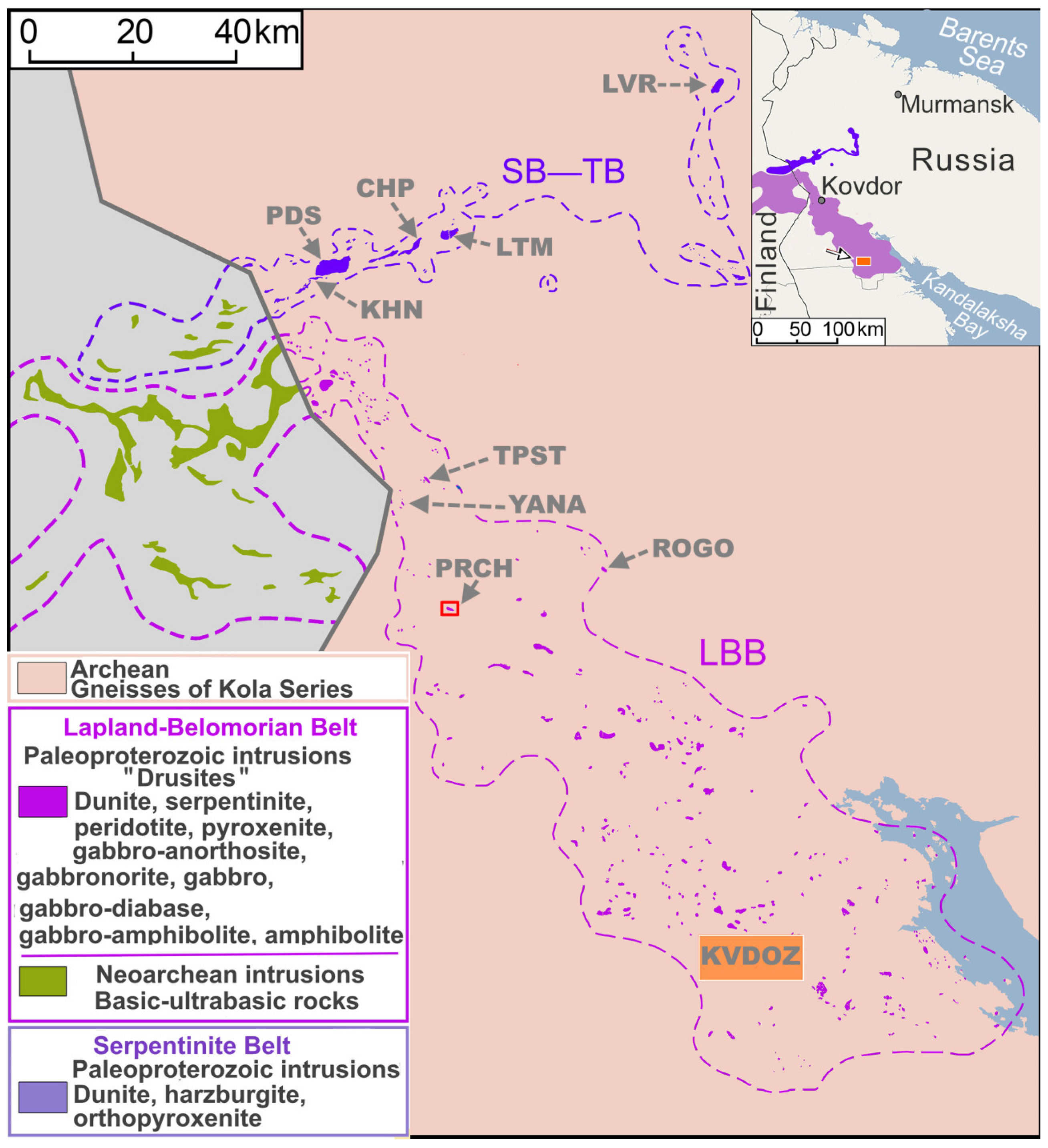

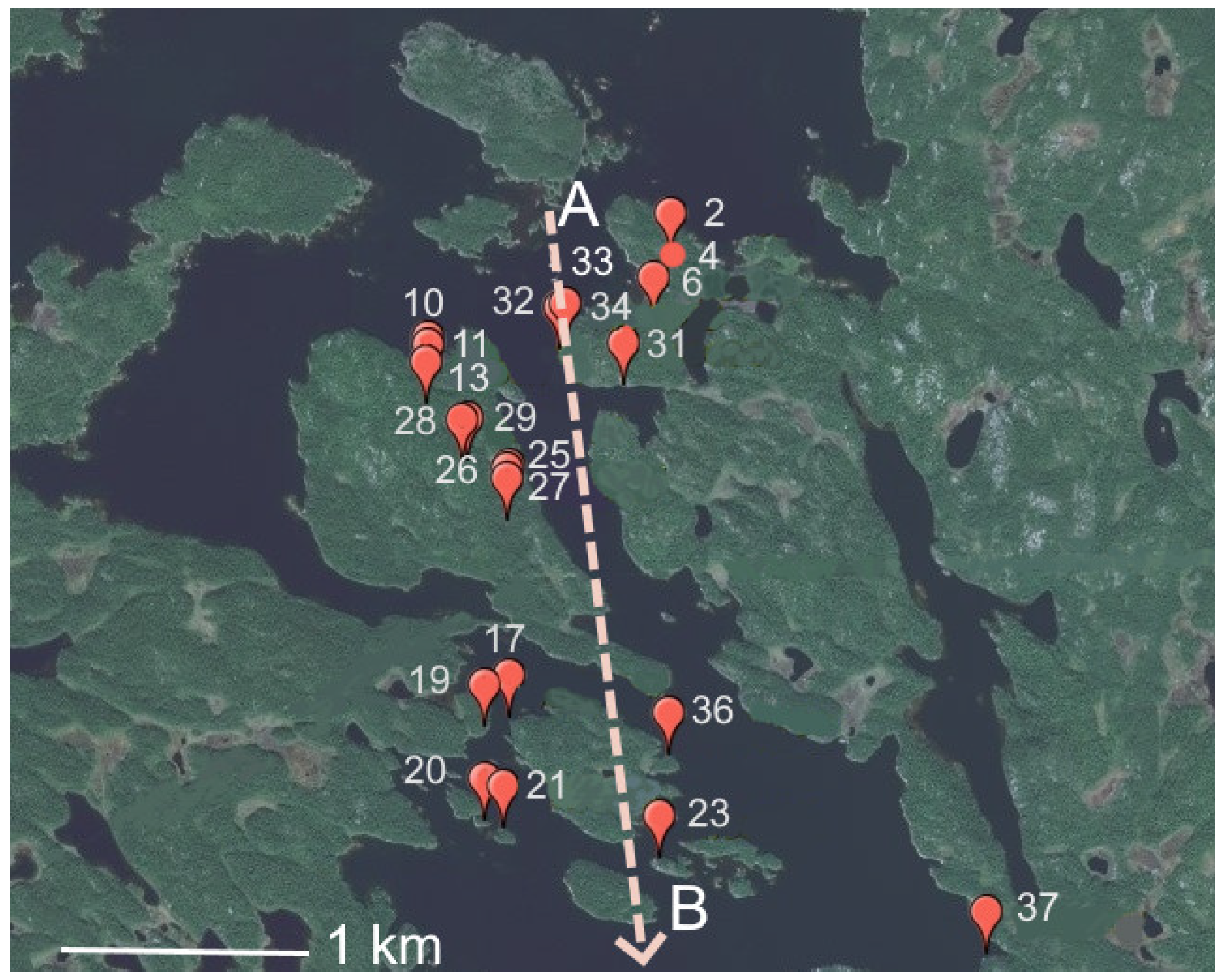




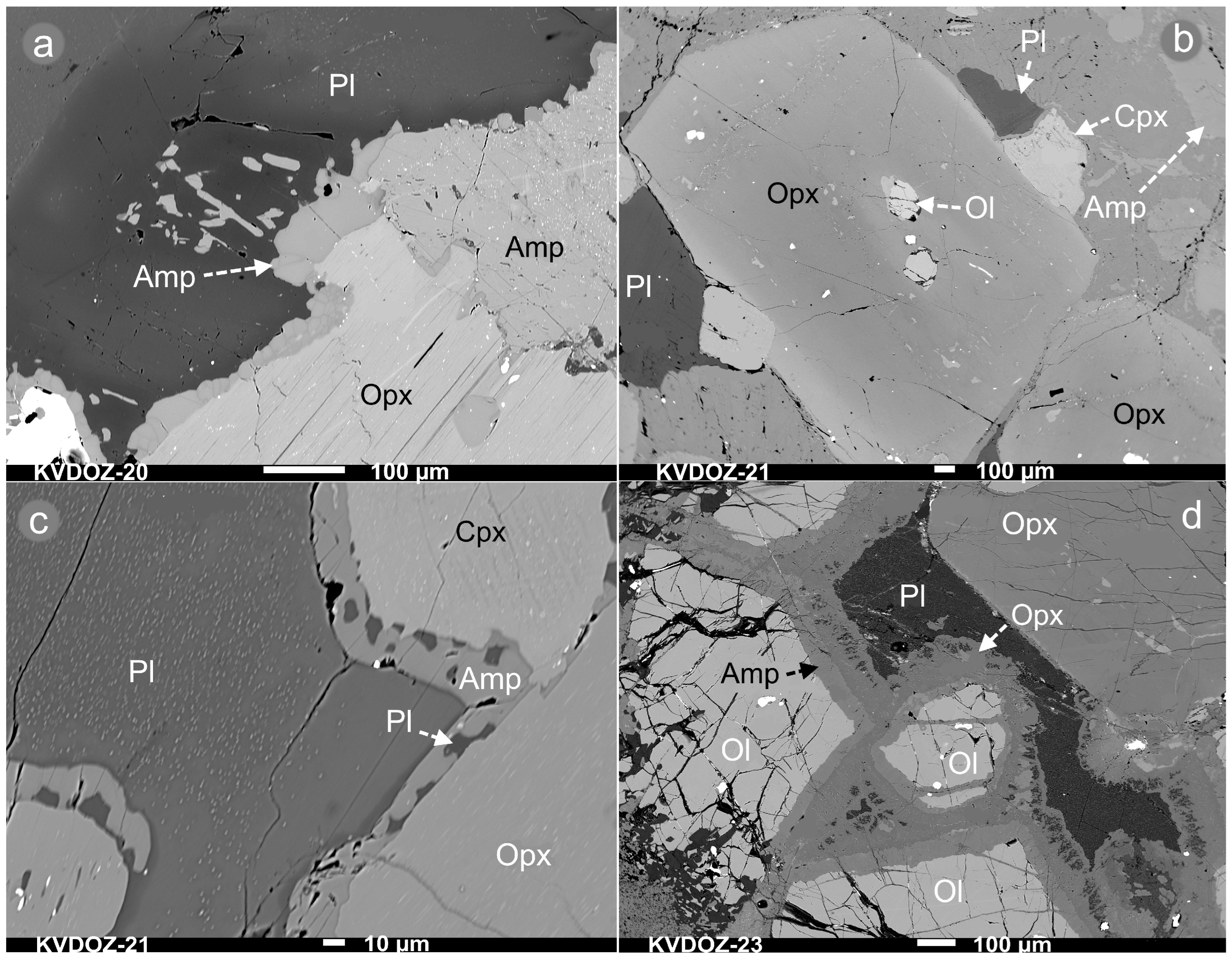


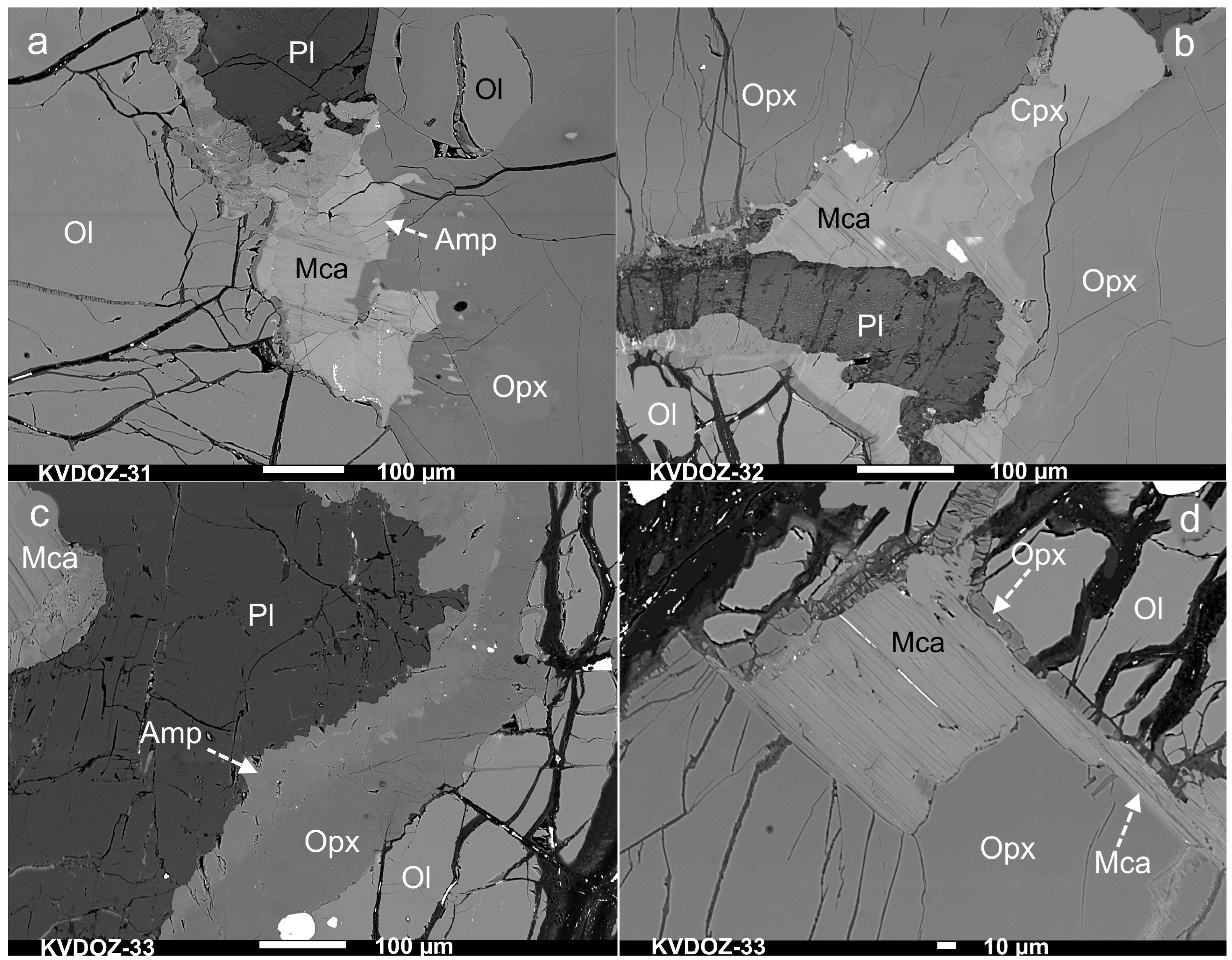
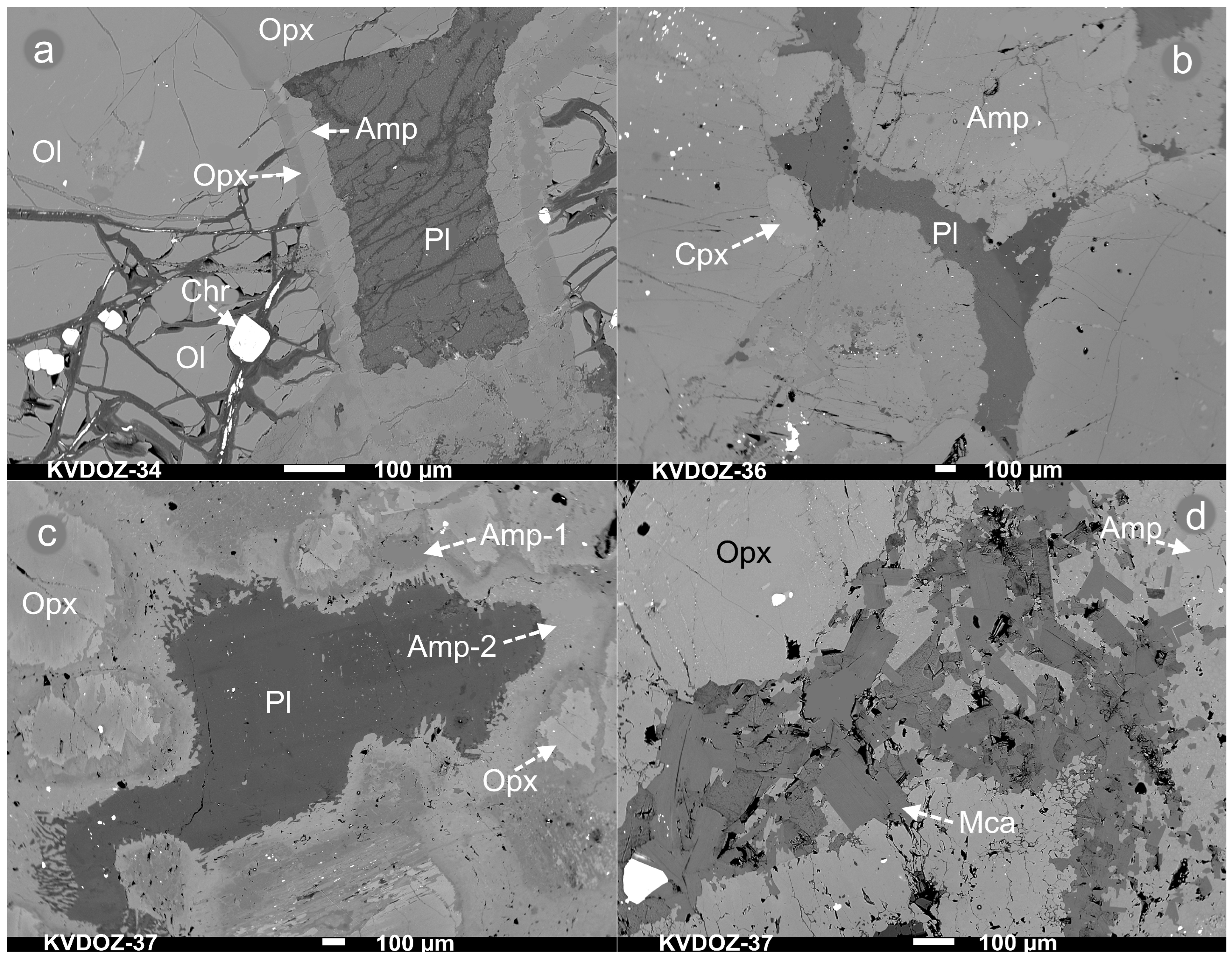




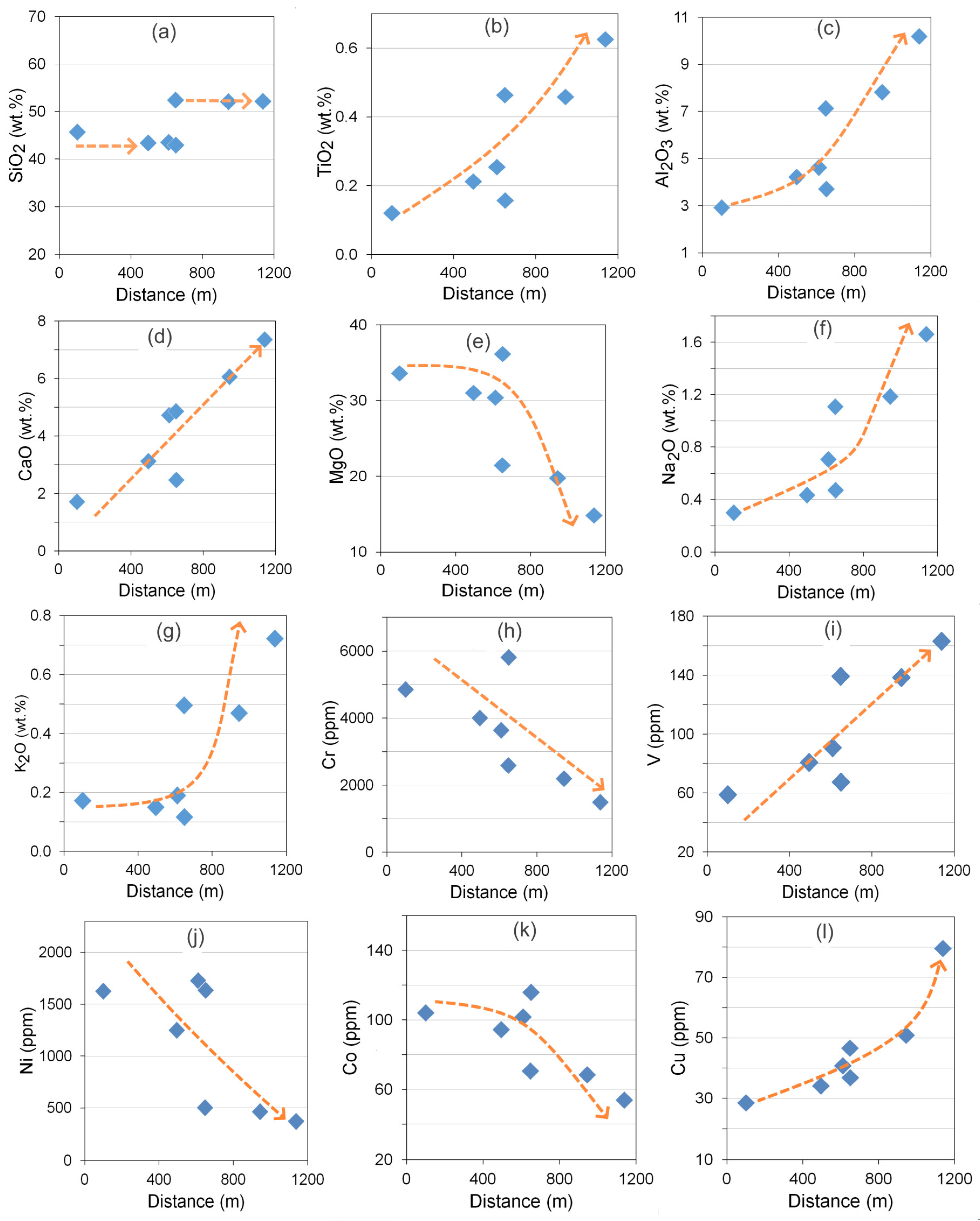
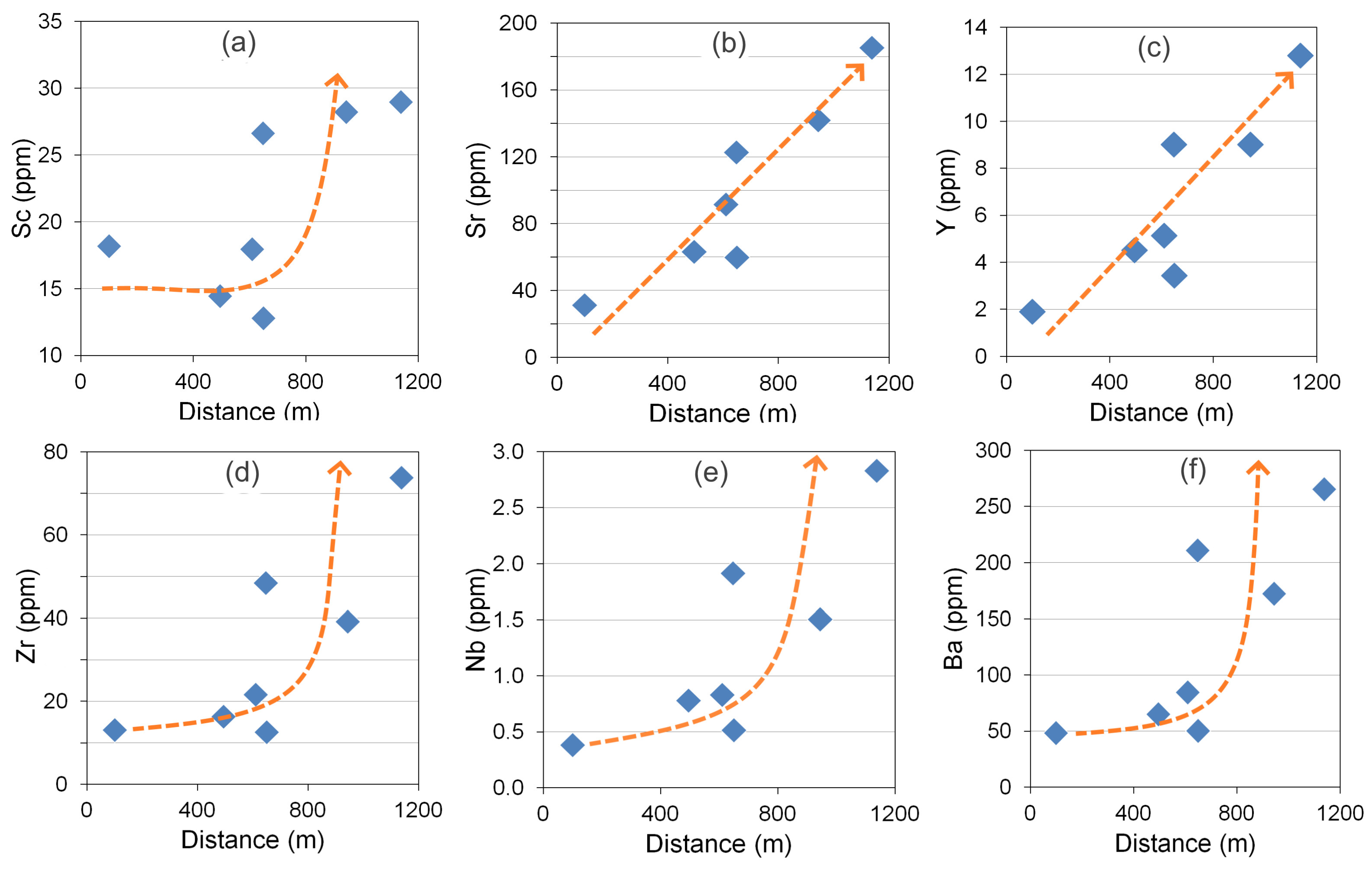

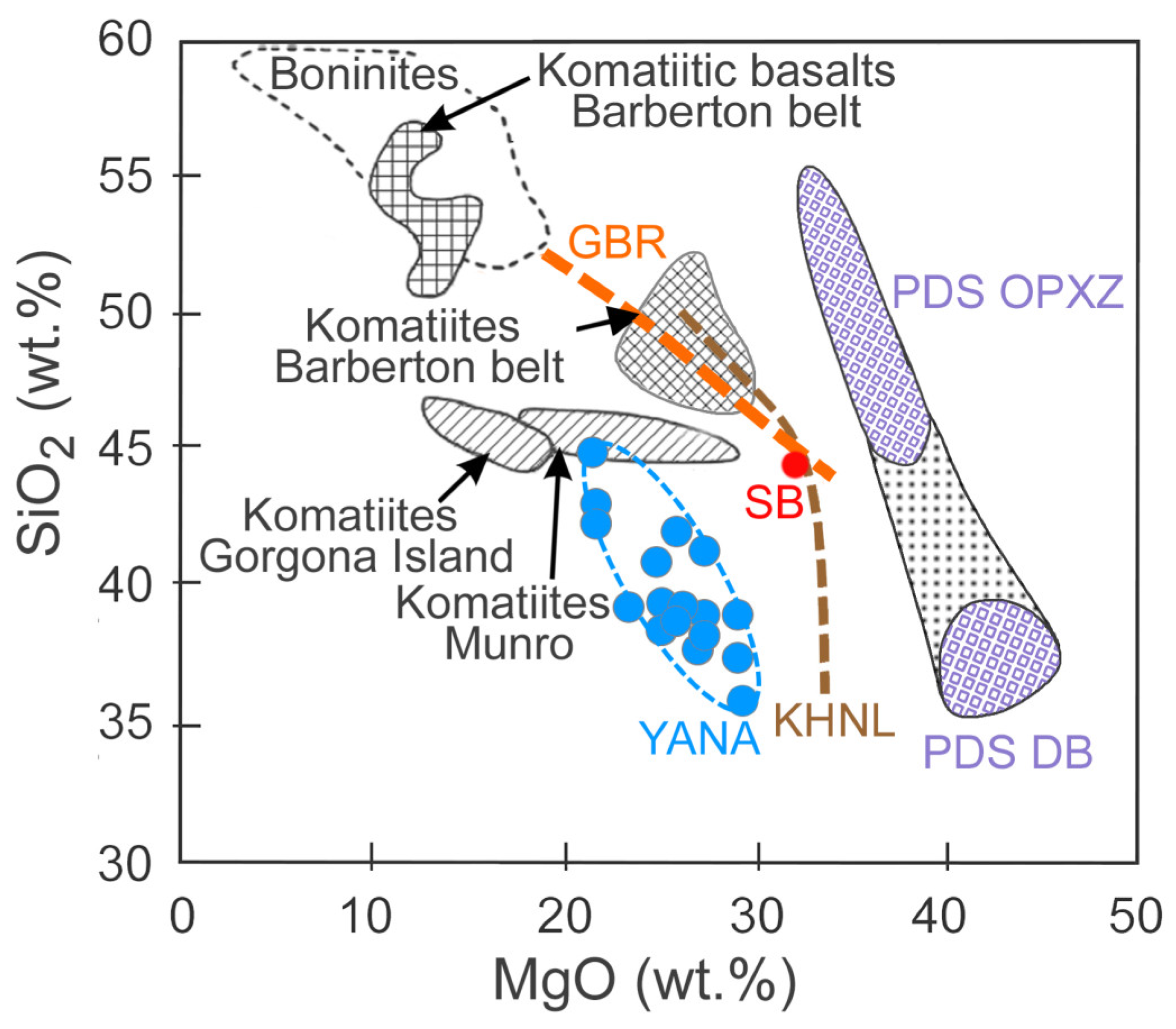


| # | Sample | Coronitic Successions | # | Sample | Coronitic Successions |
|---|---|---|---|---|---|
| 1 | KVDOZ-2 | Ol → Srp + Amp → Pl | 15 | KVDOZ-27 | Opx → Amp → Pl |
| 2 | KVDOZ-4 | Cpx → Pl | 16 | KVDOZ-27 | Opx-1 → Opx-2 + Amp → Amp → Pl (zoned) |
| 3 | KVDOZ-6 | Ol → Opx-1 → Ol → Opx-2 | 17 | KVDOZ-28 | Cpx → Amp-1 → Amp-2 → Pl |
| 4 | KVDOZ-10 | Ol → Opx → Cpx → Amp → Pl | 18 | KVDOZ-29 | Opx → Amp → Pl |
| 5 | KVDOZ-11 | Opx → Amp → Pl | 19 | KVDOZ-31 | Ol → Opx + Amp → Pl |
| 6 | KVDOZ-13 | Opx → Amp → Mca → Qz | 20 | KVDOZ-31 | Ol → Amp → Mca |
| 7 | KVDOZ-13 | Opx → Mca → Pl | 21 | KVDOZ-32 | Opx → Cpx → Mca |
| 8 | KVDOZ-17 | Ol → Opx → Amp-1 → Amp-2 → Pl | 22 | KVDOZ-33 | Ol → Opx → Amp → Pl |
| 9 | KVDOZ-19 | Ol (Opx) → Amp | 23 | KVDOZ-33 | Ol → Opx → Mca |
| 10 | KVDOZ-20 | Opx → Amp + Pl | 24 | KVDOZ-34 | Ol → Opx → Amp → Pl |
| 11 | KVDOZ-21 | Opx → Amp + Pl → Pl | 25 | KVDOZ-36 | Cpx→ Amp + Pl |
| 12 | KVDOZ-23 | Ol → Opx + Amp → Pl | 26 | KVDOZ-37 | Opx + Amp-1 → Amp-2 → Pl → Pl + Qz (symplectite) |
| 13 | KVDOZ-25 | Cpx → Amp-1 → Amp-2 → Pl | 27 | KVDOZ-37 | Opx → Mca + Amp |
| 14 | KVDOZ-26 | Opx → Amp-1 → Amp-2 → Pl |
Disclaimer/Publisher’s Note: The statements, opinions and data contained in all publications are solely those of the individual author(s) and contributor(s) and not of MDPI and/or the editor(s). MDPI and/or the editor(s) disclaim responsibility for any injury to people or property resulting from any ideas, methods, instructions or products referred to in the content. |
© 2025 by the authors. Licensee MDPI, Basel, Switzerland. This article is an open access article distributed under the terms and conditions of the Creative Commons Attribution (CC BY) license (https://creativecommons.org/licenses/by/4.0/).
Share and Cite
Barkov, A.Y.; Martin, R.F.; Barkova, L.P.; Korolyuk, V.N. Coronitic Associations at Gabrish in the Kovdozero Layered Complex in the Southern Part of the Lapland—Belomorian Belt, Kola Peninsula, Russia. Minerals 2025, 15, 565. https://doi.org/10.3390/min15060565
Barkov AY, Martin RF, Barkova LP, Korolyuk VN. Coronitic Associations at Gabrish in the Kovdozero Layered Complex in the Southern Part of the Lapland—Belomorian Belt, Kola Peninsula, Russia. Minerals. 2025; 15(6):565. https://doi.org/10.3390/min15060565
Chicago/Turabian StyleBarkov, Andrei Y., Robert F. Martin, Larisa P. Barkova, and Vladimir N. Korolyuk. 2025. "Coronitic Associations at Gabrish in the Kovdozero Layered Complex in the Southern Part of the Lapland—Belomorian Belt, Kola Peninsula, Russia" Minerals 15, no. 6: 565. https://doi.org/10.3390/min15060565
APA StyleBarkov, A. Y., Martin, R. F., Barkova, L. P., & Korolyuk, V. N. (2025). Coronitic Associations at Gabrish in the Kovdozero Layered Complex in the Southern Part of the Lapland—Belomorian Belt, Kola Peninsula, Russia. Minerals, 15(6), 565. https://doi.org/10.3390/min15060565







